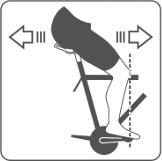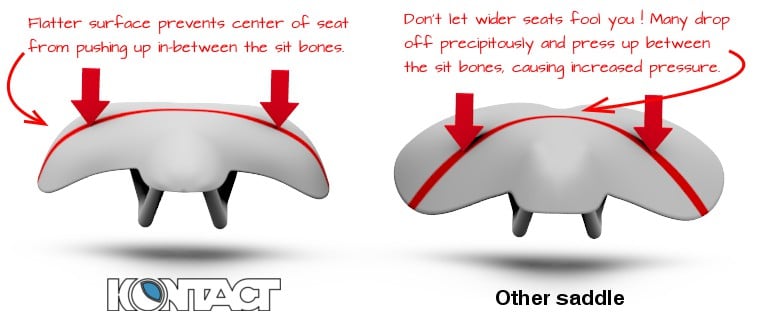FAQs
1. Are Kontact saddles specifically for men? 
2. My sit bones measure wider than your saddle. I’m worried that it will be too narrow.
3. The pressure relief on my soft tissues feels great. Does it take time to get used to the change in pressure to the sit bones?
4. How do I set up the saddle?
5. How should I be sitting on the saddle?
6. What is your RETURN POLICY?
7. How often should I replace my bicycle seat?
1. Are Kontact saddles specifically for men?
Nope. Our saddles are designed for both men AND women.
As a result of male and female genitals originating from similar structures, both sexes share analogous arteries and nerves in this region. In women, though, these arteries and nerves connect to the clitoris instead of the penis. Both the clitoris and penis are also similar in that a large portion of the organ is actually inside of the body. The majority of the clitoral tissue is located along the inner borders of the pelvic bone, which is precisely the same region where traditional saddles place the most pressure while leaning forward on a seat.
But women just need wider seats, right?
Wrong. Many recent female specific bicycle seat models have focused on the increased width of the sit bones in the female pelvis. However, it is not true that all women have a greater distance between their sit bones. The actual difference between the sexes occurs at the infrapubic angle. A female’s infrapubic angle is larger by approximately 30 degrees. This results in a wider separation between the sit bones and thus a larger pelvic opening for childbirth. The actual distance between the sit bones, however, can vary significantly among individuals. The width between the sit bones is not directly related to a person’s height or stature, and shorter individuals can often have a broader pelvis. Additionally, since the overall size of any given female pelvis may be smaller than a male’s pelvis, many women with proportionally smaller pelvises may find that their sit bones can be well supported on a seat that is usually marketed towards men.
2. My sit bones measure wider than your saddle. I’m worried that it will be too narrow.
Sit bone measuring devices used by certain brands are for recommending a saddle width – for that brand saddle. The Kontact saddle often has a wider and more accessible flat section for sit bone support than saddles with curved top profiles and wider total dimensions. The Kontact saddle offers excellent support across 92% of its width, which is easy to access due to the patented leg relief shape.
Your riding style will also influence the footprint, or contact area, of your pelvis on the saddle. If you ride in a very upright position, your sit bones will take the majority of your weight. As you lean further forward, however, the pelvis rotates forward and less pressure is placed through the sit bones. For triathletes and more aerodynamically positioned riders, more weight is transferred to the gluteal muscles and hamstrings while riding over the rear support surface of the Kontact saddle, which is a good thing, since it relieves pressure from the soft tissues in the perineum.
The further forward your pelvis rotates, the less your sit bone width matters in relation to the Kontact saddle support surface, since the sit bones are not the main weight bearing regions any longer. The Kontact saddle minimizes compression of soft tissues as you lean forward by offering a flatter rear support surface that avoids pressing up between the bony structures.
3. The pressure relief on my soft tissues feels great. Does it take time to get used to the change in pressure to the sit bones?
On a traditionally shaped saddle, the pressure is placed on the perinial/ prostate region of the cyclist (the soft tissues between the sit bones). With Kontact saddles, pressure is redistributed away from these sensative structures and moved to the sit bone regions as well as the gluteal and hamstring regions (depending on your cycling posture) as well as away from the delicate nerves and blood vessels of the perinium. The tissues (muscle, fat and skin) of the sit bone region require a period of adaptation just like any other contact point. Although the adaptation period varies, conditioning will occur with repeated rides. Lightly padded cycling shorts can help to acclimate to the change in saddle pressure. After a short while, some riders even prefer to ride the Kontact saddle with shorts without padding!
4. How do I set up the saddle?
The saddle is designed to be aligned level with the ground from the nose to the rear of the saddle. (I suggest using an actual level to measure.) Some people prefer a slight downward tilt to the nose of 1-2 degrees, although it is recommended to begin with a perfectly level saddle orientation. The fore/aft position should be such that the rider can remain over the widest rear support surface while riding. (Some people use the KOPS technique to align the rider, however, it doesn’t really matter as long as the rider is able to remain over the wide rear support surface.) The saddle should be pointed forward and not rotated to the side.

Start with the saddle level from front to rear.

Set the seat height to provide a slight bend in the knee at the bottom of the pedal stroke.

Adjust the fore-aft position to align your knee over the pedal spindle when the crank arm is horizontal and you are sitting over the rear of the saddle.
5. How should I be sitting on the saddle?
Slide back far enough that the inside of your thighs brush the transition area (where the nose of the seat contacts the rear support surface). Your sit bones should rest on the wide rear support surface. You should not have to rest any weight on the nose section of the seat – lower the saddle nose as necessary to remove any pressure so your weight is on the sit bones, solely. The nose is there purely to aid in positioning and control.
6. What is you RETURN POLICY?
Warranty:
Kontact saddles are guaranteed free of defects in materials or workmanship for one year from date of purchase. Please retain your invoice as proof of purchase and contact us for replacement information, or see your local Kontact dealer.
Returns:
All Kontact saddles purchased directly from Kontactbike.com have a 30 day refund period. We realize that no saddle can make everyone happy, so if your Kontact saddle does not fit you, please return the saddle in good condition in the original box with a copy of your invoice. You will be refunded your purchase price, less any shipping costs.
We do not accept returns on crashed or otherwise abused products.
Please send returns to (Customer is responsible for all shipping costs):
Kontact Bicycle Components
PO Box 12014
Seattle, WA 98102
Please email us for help if you are having fit issues or have any other questions. Individual dealers have their own return policies – please inquire with the store you purchased your Kontact saddle from for their policies.
7. How often should I replace my bicycle seat?
Just like padded cycling gloves or your favorite running shoes, products with padding that is subjected to prolonged or repeated force over time will eventually break down. We could tell you to replace your seat every 10 years or 100,000 miles, but really (just like running shoes) the best way to tell when to replace your old seat is by comparing your old seat to a new one. Examine your seat for rigidity and shape.
All seats wear out, especially seats with cutouts, relief areas and lots of foam, which wear out more quickly since there is less structure and surface to support your body weight.
Compare your current seat to a new one at least once a season (unless it’s suffered an impact or a lot of abuse) by assessing it for damage or decreased structural integrity/ loss of padding support. You might not develop knee pain like you might with old shoes, but a comfortable bottom is no less important!


